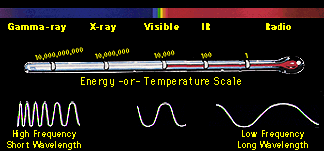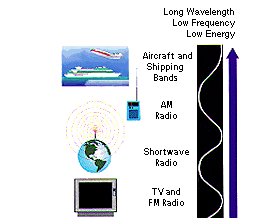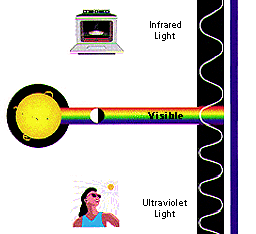
CS457: Computer Networks II
|

Electromagnetic radiation is energy that travels and spreads out as it goes. It can be described in terms of a stream of massless particles, each traveling in a wave-like pattern and moving at the speed of light. The electromagnetic spectrum is full range of frequencies, from radio waves to gamma-rays, that characterizes light. All wireless transmissions utilize some part of the electromagnetic spectrum.

|
Radio Waves -- Electromagnetic radiation that has the lowest frequency, the longest wavelength, with wavelengths from a few millimeters to about twenty meters.
Radio transmissions are used for public broadcast of radio and television programs, private communication devices like portable phones and in some cases, for transmission of computer data. Informally, a network that uses electromagnetic radio waves is said to operate at radio frequency, and the transmissions are referred to as RF transmissions. For the propagation and interception of radio waves, a transmitter and receiver are needed. A radio wave carries information-bearing signals; the information may be encoded directly on the wave by periodically interrupting its transmission (like a telegraph) or impressed on the carrier frequency by a process called MODULATION, e.g., amplitude modulation (AM) or frequency modulation (FM). |

|
Microwaves -- Electromagnetic radiation that has wavelength between 1 mm and 30 cm.
Electromagnetic radiation above the RF transmission ranges can also be used to transport information. In particular, many long-distance telephone companies use microwave transmissions to carry telephone conversations. Some companies have even installed microwave communication systems to facilitate their network system. Although microwaves are just a higher frequency version of radio waves, they have different properties. Instead of broadcasting in all directions, a microwave transmission can be aimed in a single direction, preventing others from intercepting the signal. Microwave transmissions also can carry more data than RF transmissions. Microwave transmissions, however, cannot penetrate metal and require a clear path between the transmitter and receiver. As a result, most microwave transmissions systems are implemented with two towers that are taller than the surrounding buildings and trees, each with a transmitter aimed directly at the receiver on the other end. |


|
Infrared -- Electromagnetic radiation at wavelengths longer than the red end of visible light and shorter than microwaves (roughly between 1 and 100 microns).
The wireless remote control devices used with televisions or some battery operated toys utilize infrared transmissions. Although Infrared hardware is inexpensive compared to other technology and do not require antennas, they have a limited range because they are not strong enough to penetrate the walls in most rooms. Computer networks can use infrared technology for data communication. For example, portable computers with built-in infrared communication hardware could remain connected to a network in a room specially designed with a single infrared connection. |